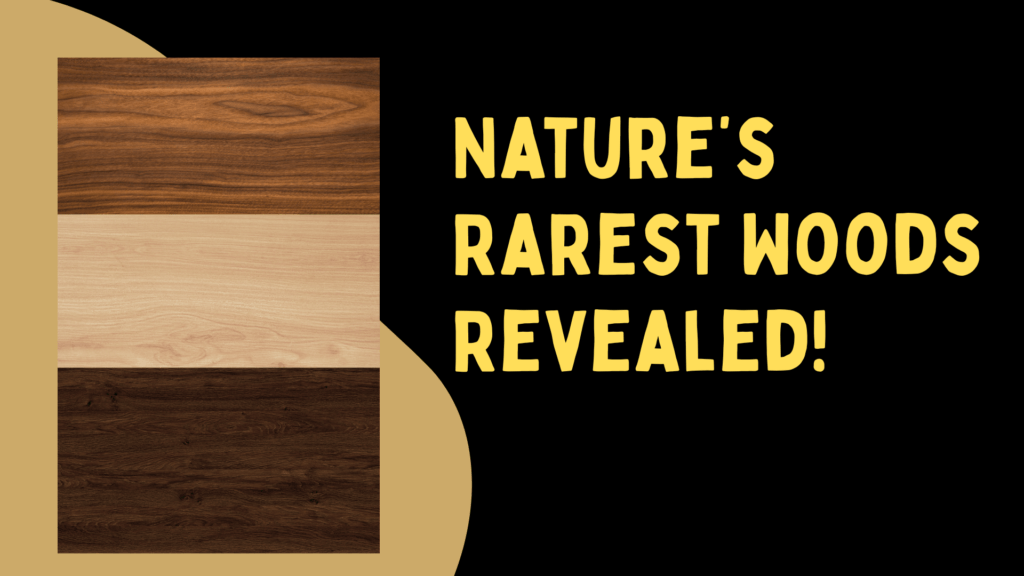
Woods of Wonder: Discovering Nature’s Rarest and Most Stunning Timbers
Nature’s most beautiful wonders often lie hidden in forests, where special trees produce some of the world’s rarest and most stunning woods. These woods have fascinated artists, craftsmen, and collectors for centuries.
People love them not only because they look beautiful but also because of their special qualities and the stories they carry. Let’s take a closer look at ten amazing woods: Thuya, Lignum Vitae, Ziricote, Bocote, Bishopwood, Padauk, Bubinga, Ebony, Sapele, and Sheesham.
1. Thuya Wood
Botanical Name: Tetraclinis articulata
Native Range: Atlas Mountains in Morocco, Algeria, and Tunisia
What is Thuya Wood?
Thuya wood is a small, slow-growing conifer tree that rarely grows taller than 60 feet. The most valuable part of the Thuya tree is its burl, which forms as a growth around the roots or trunk. The burl has a very unique pattern—swirls, knots, and ripples—making it highly sought after in woodworking.
The wood has a sweet, spicy scent, which is long-lasting and natural, and it also has oils that protect it from insects and decay. Thuya burl is moderately hard, with a Janka hardness of around 1,400 lbf.
How is Thuya Wood Used?
Thuya is commonly used in fine furniture, jewelry boxes, marquetry, and intarsia (a type of woodworking involving inlays). The wood’s unusual grain and the lingering fragrance make it perfect for luxury items like perfume boxes and keepsakes.
Why is Thuya Special?
Thuya is now rare and is protected by law in Morocco. Its slow growth makes it valuable, and because it is considered a “living fossil,” it needs to be carefully managed to avoid overharvesting.
2. Lignum Vitae
Botanical Name: Guaiacum officinale, Guaiacum sanctum
Native Range: Caribbean, northern South America
What is Lignum Vitae?
Lignum Vitae is the heaviest wood in the world. Its heartwood is a dark olive-green to nearly black color, with faint streaks. It contains a resin that makes it naturally self-lubricating, which helps it resist rot and wear. This wood is so dense it sinks in water. Its weight and strength make it one of the most durable woods available.
How is Lignum Vitae Used?
This wood has been historically used for ship bearings, pulleys, and mortars because it doesn’t need external lubricants to operate in water. It is also used for making tool handles, mallets, and croquet balls.
Why is Lignum Vitae Special?
Due to its heavy weight and hardness, it requires specialized tools to work with. However, its unique properties and beauty make it valuable, even though it’s now a protected wood due to overharvesting.
3. Ziricote Wood
Botanical Name: Cordia dodecandra
Native Range: Mexico, Belize, Guatemala
What is Ziricote Wood?
Ziricote is famous for its striking heartwood that features rich brown and olive tones with unique veining patterns that resemble landscapes or rivers. This wood is dense, weighing around 830 kg/m³, and has a Janka hardness of 1,970 lbf.
How is Ziricote Used?
Ziricote wood is often used in the making of fine guitars, ukuleles, and other stringed instruments because of its excellent tonal properties. It is also popular for high-end furniture, luxury cabinetry, and decorative veneers.
Why is Ziricote Special?
Ziricote is rare and slow-growing. Each piece has its own unique look, making it especially prized by fine woodworkers. While it’s not endangered, its slow growth makes it a precious resource.
4. Bocote Wood
Botanical Name: Cordia spp.
Native Range: Mexico, Central America
What is Bocote Wood?
Bocote wood is a beautiful golden to brownish-yellow color with dark streaks and spots. It can have irregular rings and eyes, making it visually appealing. It is dense, weighing around 850 kg/m³, with a Janka hardness of about 2,200 lbf.
How is Bocote Used?
Bocote is often used for ornamental furniture, musical instruments, rifle stocks, knife handles, and veneers. Its oily nature helps it resist decay and insects.
Why is Bocote Special?
Bocote is valued for its striking appearance and high quality, making it perfect for special, custom pieces of furniture and fine art.
5. Bishopwood
Botanical Name: Bischofia javanica
Native Range: Tropical Asia (India, China, Southeast Asia)
What is Bishopwood?
Bishopwood is a fast-growing deciduous tree that produces reddish to chocolate-brown heartwood. Its grain is mostly straight, with a medium texture.
How is Bishopwood Used?
Bishopwood is easy to work with and is commonly used for general timber, flooring, cabinetry, veneer, and boatbuilding.
Why is Bishopwood Special?
Bishopwood has the unique ability to fix nitrogen in the soil, improving soil health. This makes it useful in agroforestry and reforestation projects, helping other plants grow.
6. Padauk Wood
Botanical Name: Pterocarpus soyauxii (African), Pterocarpus indicus (Asian)
Native Range: Central/West Africa, Southeast Asia
What is Padauk Wood?
Padauk wood is known for its vibrant orange-red color that darkens over time into a rich brown. The wood is moderately dense and has a Janka hardness of about 1,970 lbf.
How is Padauk Used?
Padauk is used for flooring, furniture, carvings, and musical instruments. It is also popular for specialty items like jewelry boxes and tool handles.
Why is Padauk Special?
In African and Asian cultures, Padauk has significance in sculpture and music. Its color and resistance to decay make it perfect for outdoor furniture.
7. Bubinga Wood
Botanical Name: Guibourtia demeusei, Guibourtia tessmannii
Native Range: Equatorial Africa
What is Bubinga Wood?
Bubinga wood is a striking wood with pinkish-red, violet, and brown hues, often displaying dramatic figuring such as flame-like patterns. It is dense and hard, with a Janka hardness of 2,410 lbf.
How is Bubinga Used?
Bubinga is used in luxury furniture, veneers, musical instruments, and knife handles. It is especially beautiful when quarter-sawn, showing off its unique ribbon-like patterns.
Why is Bubinga Special?
Bubinga has become rare due to overexploitation, and it is now a protected species in some areas. Sustainable harvesting is necessary to preserve it.
8. Ebony Wood
Botanical Name: Diospyros spp.
Native Range: Tropical Africa, Asia, Sri Lanka, Madagascar
What is Ebony Wood?
Ebony wood is known for its pure black color and high density. It is one of the heaviest woods, weighing between 950-1,200 kg/m³, and has a mirror-like finish when polished.
How is Ebony Used?
Ebony is used for making piano keys, fingerboards, chess pieces, and fine inlays. Its smooth texture and dark color make it highly prized for luxury items.
Why is Ebony Special?
Ebony is one of the most endangered woods due to overharvesting, especially for musical instruments. It remains a symbol of prestige and is highly valued.
9. Sapele Wood
Botanical Name: Entandrophragma cylindricum
Native Range: West and Central Africa
What is Sapele Wood?
Sapele wood is a reddish-brown wood with a straight grain that sometimes produces ribbon-like patterns when quarter-sawn. It has a density of about 640 kg/m³ and a Janka hardness of 1,410 lbf.
How is Sapele Used?
Sapele is often used for furniture, cabinetry, paneling, and musical instruments, especially for guitars and pianos.
Why is Sapele Special?
Sapele is more abundant than some other luxury timbers, and responsibly managed plantations help reduce pressure on mahogany forests.
10. Sheesham Wood
Botanical Name: Dalbergia sissoo
Native Range: Indian subcontinent (India, Pakistan, Nepal)
What is Sheesham Wood?
Sheesham, also known as Indian Rosewood, has a golden-brown color with dark streaks. It is highly durable and resistant to warping.
How is Sheesham Used?
Sheesham is commonly used for carved furniture, musical instruments, and high-quality cabinetry. Its resistance to water makes it suitable for use in humid regions.
Why is Sheesham Special?
Sheesham is central to Indian craftsmanship and is widely exported as a symbol of South Asian artisanal skill.
Final Thoughts
Each of these woods is a gift from nature, showing the patience and artistry of the forest. Their unique beauty, durability, and stories make them valuable not just as raw materials but as connections to the natural world.
These woods need careful management and sustainable practices to ensure they are available for future generations. They represent both the richness of our planet and the need to preserve it for the future.

